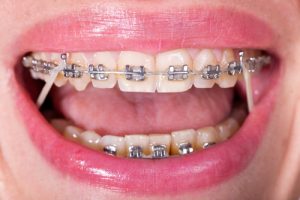Invisalign® vs. Braces: Which Is Right for You?
Choosing the Best Treatment for Your Needs

Dr. Stephen Grussmark is one of the top orthodontists in Miami, FL, and has helped countless patients straighten their smiles with both treatments. Explore the contrasting characteristics of Invisalign and braces, and how Dr. Grussmark can help you make an informed decision.
Guide to Invisalign
What is Invisalign?
Invisalign is a modern orthodontic treatment that employs a series of clear, removable aligners to straighten teeth gradually. Unlike traditional braces, Invisalign aligners are virtually invisible, offering a discreet option for teeth alignment.
How Does Invisalign Work?
Invisalign treatment begins with a consultation where our orthodontist creates a 3D digital image of your teeth. Based on this image, a customized treatment plan is developed. You’ll receive a series of clear aligners, each designed to be worn for approximately two weeks before moving on to the next set. Over time, the aligners gently shift your teeth into their desired positions.
Advantages of Invisalign
- Virtually invisible when worn
- Removable aligners for convenience
- Smooth and comfortable plastic material
- No dietary restrictions
- Easier maintenance and oral hygiene
- Customized treatment plan
Limitations of Invisalign
- May not be suitable for complex dental cases
- Requires high compliance for successful treatment
- Higher cost compared to traditional braces
- Regular aligner changes required
- Potential for temporary speech changes
- Not recommended for individuals who are prone to losing or misplacing items
Guide to Traditional Braces
What Are Traditional Braces?

How Do Traditional Braces Work?
The metal brackets of traditional braces are strategically placed on each tooth, and the archwire is threaded through them. Over time, the tension in the wire applies pressure to the teeth, gradually shifting them into their proper positions. Orthodontic adjustments are made periodically to ensure progress and achieve the desired results.
Advantages of Traditional Braces
- Highly effective for complex dental cases
- Precise control of tooth movement
- A fixed appliance that requires no compliance
- Lower cost compared to Invisalign in some cases
- No aligner changes required
- Can be used for jaw adjustments
Limitations of Traditional Braces
- Visible metal brackets and wires
- Discomfort and irritation during adjustment periods
- Challenging oral hygiene maintenance
- Dietary restrictions to avoid damage
- Regular orthodontic appointments for adjustments
- Longer treatment duration in some cases
Comparing Invisalign and Braces
Effectiveness of Alignment
Both Invisalign and traditional braces are effective in aligning teeth and correcting various dental issues. However, traditional braces are generally more suitable for complex cases that require significant tooth movement or jaw adjustments.
Visibility and Aesthetic Appeal
Invisalign aligners are virtually invisible when worn, making them an excellent choice for individuals seeking discreet orthodontic treatment. On the other hand, traditional braces are more noticeable due to the metal brackets and wires.
Comfort and Convenience
Invisalign aligners are made from smooth plastic, providing a more comfortable experience compared to the metal components of traditional braces. Traditional braces, being fixed appliances, require certain dietary adjustments to avoid damaging the brackets and wires.
Maintenance and Oral Hygiene
Invisalign aligners are easily removable, allowing for regular brushing and flossing. This promotes better oral hygiene compared to traditional braces, which require extra care and specific techniques to clean around the brackets and wires. However, you don’t have to worry about removing and replacing braces after each meal.
Make the Best Decision For Your Oral Health With Dr. Grussmark
Invisalign aligners and metal braces each have unique benefits and drawbacks. Remember, whichever option you choose, the goal remains the same — achieving a confident, beautiful smile. Embrace the journey and trust in the expertise of your Miami orthodontist to guide you toward the best choice for your unique circumstances.
Call our Miami, FL, office at (305) 441-1200 or fill out our online contact form to schedule your consultation with Dr. Grussmark today!

